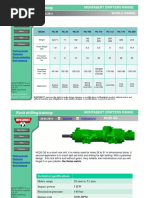Badminton
Badminton
Uploaded by
James MichaelCopyright:
Available Formats
Badminton
Badminton
Uploaded by
James MichaelCopyright
Available Formats
Share this document
Did you find this document useful?
Is this content inappropriate?
Copyright:
Available Formats
Badminton
Badminton
Uploaded by
James MichaelCopyright:
Available Formats
HISTORY AND ORIGINS OF BADMINTON
FACTS AND INFORMATION ABOUT THE GAME The origins of the game of badminton date back at least two thousand years to the game of battledore and shuttlecock played in ancient Greece, China and India. A very long history for one of the Olympics newest sports! Badminton took its name from Badminton House in Gloucestershire, the ancestral home of the Duke of Beaufort, where the sport was played in the last century. Gloucestershire is now the base for the International Badminton Federation. The IBF was formed in 1934 with 9 members Canada, Denmark, ,France, Netherlands, England, New Zealand, Ireland, Scotland and Wales. The United States joined 4 years later. Membership increased steadily over the next few years with a surge in new members after the Olympic Games debut at Barcelona. The 1st big IBF tournament was the Thomas Cup (Mens world team championships) in 1948. Since then, the number of world events has increased to 7, with the addition of the Uber Cup (ladies team), World Championships, Sudirman Cup (mixed team), World Juniors, World Grand Prix Finals and the World Cup. The World Cup invitational event started in 1981 and is organized by the International Management Group (IMG). The World Cup series is due to end in 1997 and the IBF is considering organizing exhibition matches featuring the worlds top players to replace the World Cup. For the recent Thomas & Uber Cups in Hong Kong, the sale of commercial and television rights was a multi-million dollar contract. And its not just in Asia. In Europe, also, theres a growing number of companies bidding for rights. Television companies world-wide are already buying exclusive rights to the 1997 World Championships, to be held in Glasgow, Scotland. Badminton is a racquet sport played by either two opposing players (singles) or two opposing pairs (doubles), who take positions on opposite halves of a rectangular court that is divided by a net. Players score points by striking a shuttlecock with their racquet so that it passes over the net and lands in their opponents' half of the court. Each side may only strike the shuttlecock once before it passes over the net. A rally ends once the shuttlecock has struck the floor. The shuttlecock (or shuttle) is a feathered projectile whose unique aerodynamic properties cause it to fly differently from the balls used in most racquet sports; in particular, the feathers create much higher drag, causing the shuttlecock to decelerate more rapidly than a ball. Shuttlecocks have a much higher top speed, when compared to other racquet sports. Because shuttlecock flight is affected by wind, competitive badminton is played indoors. Badminton is also played outdoors as a casual recreational activity, often as a garden or beach game.
Playing court dimensions
The court is rectangular and divided into halves by a net. Courts are usually marked for both singles and doubles play, although badminton rules permit a court to be marked for singles only. The doubles court is wider than the singles court, but both are of same length. The exception, which often causes confusion to newer players, is that the doubles court has a shorter serve-length dimension. The full width of the court is 6.1 metres (20 ft), and in singles this width is reduced to 5.18 metres (17 ft). The full length of the court is 13.4 metres (44 ft). The service courts are marked by a centre line dividing the width of the court, by a short service line at a distance of 1.98 metres (6 ft 6 inch) from the net, and by the outer side and back boundaries. In doubles, the service court is also marked by a long service line, which is 0.76 metres (2 ft 6 inch) from the back boundary. The net is 1.55 metres (5 ft 1 inch) high at the edges and 1.524 metres (5 ft) high in the centre. The net posts are placed over the doubles sidelines, even when singles is played. The minimum height for the ceiling above the court is not mentioned in the Laws of Badminton. Nonetheless, a badminton court will not be suitable if the ceiling is likely to be hit on a high serve. EQUIPMENTS Racquet
Badminton racquets are lightweight, with top quality racquets weighing between 70 and 95 grams (2.4 to 3.3 ounces) not including grip or strings. They are composed of many different materials ranging from carbon fibre composite (graphite reinforced plastic) to solid steel, which may be augmented by a variety of materials. Carbon fibre has an excellent strength to weight ratio, is stiff, and gives excellent kinetic energy transfer. Before the adoption of carbon fibre composite, racquets were made of light metals such as aluminium. Earlier still, racquets were made of wood. Cheap racquets are still often made of metals such as steel, but wooden racquets are no longer manufactured for the ordinary market, because of their excessive mass and cost. Nowadays, nanomaterials such asfullerene and carbon nanotubes are added to rackets giving them greater durability. There is a wide variety of racquet designs, although the laws limit the racquet size and shape. Different racquets have playing characteristics that appeal to different players. The traditional oval head shape is still available, but an isometric head shape is increasingly common in new racquets. Strings Badminton strings are thin, high performing strings in the range of about 0.62 to 0.73 mm thickness. Thicker strings are more durable, but many players prefer the feel of thinner strings. String tension is normally in the range of 80 to 160 N (18 to 36 lbf). Recreational players generally string at lower tensions than professionals, typically between 80 and 110 N (18 and 25 lbf). Professionals string between about 110 and 160 N (25 and 36 lbf). Some string manufacturers measure the thickness of their strings under tension so they are actually thicker then than specified when slack. Ashaway Micropower is actually 0.7mm but Yonex BG-66 is about 0.72mm. It is often argued that high string tensions improve control, whereas low string tensions increase power. The arguments for this generally rely on crude mechanical reasoning, such as claiming that a lower tension string bed is more bouncy and therefore provides more power. This is in fact incorrect, for a higher string tension can cause the shuttle to slide off the racquet and hence make it harder to hit a shot accurately. An alternative view suggests that the optimum tension for power depends on the player; the faster and more accurately a player can swing their racquet, the higher the tension for maximum power. Neither view has been subjected to a rigorous mechanical analysis, nor is there clear evidence in favour of one or the other. The most effective way for a player to find a good string tension is to experiment. Grip The choice of grip allows a player to increase the thickness of his racquet handle and choose a comfortable surface to hold. A player may build up the handle with one or several grips before applying the final layer. Players may choose between a variety of grip materials. The most common choices are PU synthetic grips or towelling grips. Grip choice is a matter of personal preference. Players often find that sweat becomes a problem; in this case, a drying agent may be applied to the grip or hands, sweatbands may be used, the player may choose another grip material or change his grip more frequently. There are two main types of grip: replacement grips and overgrips. Replacement grips are thicker, and are often used to increase the size of the handle. Overgrips are thinner (less than 1 mm), and are often used as the final
layer. Many players, however, prefer to use replacement grips as the final layer. Towelling grips are always replacement grips. Replacement grips have an adhesive backing, whereas overgrips have only a small patch of adhesive at the start of the tape and must be applied under tension; overgrips are more convenient for players who change grips frequently, because they may be removed more rapidly without damaging the underlying material.
Shuttlecock A shuttlecock (often abbreviated to shuttle; also called a birdie) is a high-drag projectile, with an open conical shape: the cone is formed from sixteen overlapping feathers embedded into a rounded cork base. The cork is covered with thin leather or synthetic material. Synthetic shuttles are often used by recreational players to reduce their costs as feathered shuttles break easily. These nylon shuttles may be constructed with either natural cork or synthetic foam base, and a plastic skirt. Shoes Badminton shoes are lightweight with soles of rubber or similar high-grip, non-marking materials. Compared to running shoes, badminton shoes have little lateral support. High levels of lateral support are useful for activities where lateral motion is undesirable and unexpected. Badminton, however, requires powerful lateral movements. A highly built-up lateral support will not be able to protect the foot in badminton; instead, it will encourage catastrophic collapse at the point where the shoe's support fails, and the player's ankles are not ready for the sudden loading, which can cause sprains. For this reason, players should choose badminton shoes rather than general trainers or running shoes, because proper badminton shoes will have a very thin sole, lower a person's centre of gravity, and therefore result in fewer injuries. Players should also ensure that they learn safe and proper footwork, with the knee and foot in alignment on all lunges. This is more than just a safety concern: proper footwork is also critical in order to move effectively around the court.
ALL ABOUT BADMINTON
James Michael Pueyo MT 2-1 Ms. Grajo
You might also like
- Model 4 Operating and Maintenance ManualDocument164 pagesModel 4 Operating and Maintenance Manualfauzi endraNo ratings yet
- BadmintonDocument9 pagesBadmintonRon Jorel B. LibunaoNo ratings yet
- BadmintonDocument3 pagesBadmintonIshmael Gabriel AguilarNo ratings yet
- BADMINTON Peh Dual SharikaDocument4 pagesBADMINTON Peh Dual SharikaBernadeth BaiganNo ratings yet
- Badminton Is A Racquet Sport Played by Either Two Opposing Players (Singles) or Two Opposing PairsDocument4 pagesBadminton Is A Racquet Sport Played by Either Two Opposing Players (Singles) or Two Opposing Pairsnaffy03No ratings yet
- BadmintonDocument20 pagesBadmintonJerrica Mae GalvezNo ratings yet
- Badminton Sport: Submitted By: Manav Lakdawala Institution:l.p Savani International SchoolDocument35 pagesBadminton Sport: Submitted By: Manav Lakdawala Institution:l.p Savani International SchoolManav LakdawalaNo ratings yet
- BadmintonDocument29 pagesBadmintonMarjorie Dio CastillonNo ratings yet
- BadmintonDocument7 pagesBadmintonZion Lim UyNo ratings yet
- Badminton: Badminton Is A Racquet Sport PlayedDocument7 pagesBadminton: Badminton Is A Racquet Sport PlayedMichelle Uzumakinaruto TanNo ratings yet
- Badminton Project 1Document4 pagesBadminton Project 1Toshan KaushikNo ratings yet
- Pe Mo Liu StuffDocument4 pagesPe Mo Liu StuffhatemalkyNo ratings yet
- History of BadmintonDocument4 pagesHistory of BadmintonVoltaire M. BernalNo ratings yet
- BadmintonDocument3 pagesBadmintonanon_114695No ratings yet
- Scoring and Equiments in BadmintonDocument3 pagesScoring and Equiments in BadmintonRonaldNo ratings yet
- BADMINTONDocument5 pagesBADMINTONDenice VicenteNo ratings yet
- BADMINTONDocument69 pagesBADMINTONalvinbelerbelchez17No ratings yet
- Equipments For BadmintonDocument4 pagesEquipments For BadmintonAubrey Anne Ilagan100% (2)
- BadmintonDocument17 pagesBadmintonBryan SarmientoNo ratings yet
- History of BadmintonDocument7 pagesHistory of BadmintonNnGg LpNo ratings yet
- History of The Game: Badminton: Badminton Battledore - A New Game, But Unfortunately No Copy Has SurvivedDocument5 pagesHistory of The Game: Badminton: Badminton Battledore - A New Game, But Unfortunately No Copy Has SurvivedTrisha DarnaylaNo ratings yet
- Physical Education Project FileDocument12 pagesPhysical Education Project FileArt Gallery0% (1)
- Physical Education 3 Individual and Dual Sports: BadmintonDocument56 pagesPhysical Education 3 Individual and Dual Sports: Badmintonpey PeyNo ratings yet
- PEH BadmintonDocument15 pagesPEH BadmintonAislinn Sheen AcasioNo ratings yet
- Badminton: 1. What Is The History of Badminton?Document15 pagesBadminton: 1. What Is The History of Badminton?Kathleen Llacer PiczonNo ratings yet
- Badminton: All You Need To KnowDocument30 pagesBadminton: All You Need To KnowRod CyNo ratings yet
- History and Development: BadmintonDocument4 pagesHistory and Development: Badmintonbethany100% (1)
- BadmintonDocument21 pagesBadmintonapi-238998742No ratings yet
- P.E 103-Badminton HandoutsDocument20 pagesP.E 103-Badminton HandoutsAmiel Christian MendozaNo ratings yet
- Badminton: INVENTORY - Badminton As It Is Played Today WasDocument4 pagesBadminton: INVENTORY - Badminton As It Is Played Today WasJanna Mae GranadaNo ratings yet
- BadmintonDocument3 pagesBadmintonPankaj AgarwalNo ratings yet
- Badminton Is A Racquet Sport Played Using: Racquets Shuttlecock NetDocument3 pagesBadminton Is A Racquet Sport Played Using: Racquets Shuttlecock NetNerissa Lejano RosasNo ratings yet
- History and Development: Battledore and Shuttlecock. 1854, From The ArchiveDocument7 pagesHistory and Development: Battledore and Shuttlecock. 1854, From The ArchiveRodel Symon VillaflorNo ratings yet
- Jojenelle R. Tepait January 29, 2024 BSN-2D Physical Education 4: 1 Prelim AssignmentDocument23 pagesJojenelle R. Tepait January 29, 2024 BSN-2D Physical Education 4: 1 Prelim AssignmentJojenelle R. TepaitNo ratings yet
- Badminton Racket - 2Document11 pagesBadminton Racket - 2efekan35No ratings yet
- Badminton EssayDocument2 pagesBadminton EssayHimanshu BhardwajNo ratings yet
- Reporting About BadmintonDocument20 pagesReporting About Badmintonexonmonstere100% (2)
- Project IN Mapeh: Submitted By: Vanessa T. RiveraDocument9 pagesProject IN Mapeh: Submitted By: Vanessa T. RiveramelanyNo ratings yet
- P.E. BadmintonDocument22 pagesP.E. BadmintonZebe ZBNo ratings yet
- Badminton FinalDocument7 pagesBadminton FinalJohn Allen TejamoNo ratings yet
- Badminton LessonsDocument9 pagesBadminton LessonsCamille MaterumNo ratings yet
- History of BadmintonDocument39 pagesHistory of BadmintonTwisha MistryNo ratings yet
- Presentation 1Document11 pagesPresentation 1atharvsinghgwNo ratings yet
- Equipment and Facilities of BadmintonDocument35 pagesEquipment and Facilities of BadmintonMish LeiNo ratings yet
- Pe Report-BadmintonDocument20 pagesPe Report-BadmintonMonica GloriosoNo ratings yet
- P.e.3 Badminton Concept NotesDocument13 pagesP.e.3 Badminton Concept NotesAdrian SaplalaNo ratings yet
- Badminton L1Document66 pagesBadminton L1A.V. JamoraboNo ratings yet
- Facilities and EquipmentDocument3 pagesFacilities and EquipmentPauline IdraNo ratings yet
- Badminton EquipmentDocument2 pagesBadminton EquipmentDemetrio Abelardo0% (1)
- Name: Shiela Mae B. Forro Year and Course: 2 Year Bs in Biology Subject and Code: Gpe3 (2402) TIME: 8:00 AM-10:00 AMDocument16 pagesName: Shiela Mae B. Forro Year and Course: 2 Year Bs in Biology Subject and Code: Gpe3 (2402) TIME: 8:00 AM-10:00 AMShiela Mae Forro IINo ratings yet
- Badminton ReportDocument40 pagesBadminton ReportjemolofernsNo ratings yet
- IntroductionDocument32 pagesIntroductionmarudi_princess4753No ratings yet
- WEEK 3 - Facilities and Equipment - Basic Skills in Badminton - Part 1Document22 pagesWEEK 3 - Facilities and Equipment - Basic Skills in Badminton - Part 1Jhonas PatayonNo ratings yet
- Enero, Pamela DaniseDocument11 pagesEnero, Pamela DaniseCarmela EstradaNo ratings yet
- 122 - PE3 - Lesson Proper For Week 1Document6 pages122 - PE3 - Lesson Proper For Week 1Alexander CastroNo ratings yet
- BadmintonDocument7 pagesBadmintonAVEGAIL SALUDONo ratings yet
- Grade 11 PE "Badminton"Document34 pagesGrade 11 PE "Badminton"Kenzie AnchetaNo ratings yet
- Jade V. Capalac Ab Polsci 2 Year PE 3 Section 13A67Document4 pagesJade V. Capalac Ab Polsci 2 Year PE 3 Section 13A67Jade Tumabini Villamor CapalacNo ratings yet
- Pe AssignmentDocument22 pagesPe AssignmentSheina JavidNo ratings yet
- Badminton Gears and EquipmentsDocument4 pagesBadminton Gears and EquipmentsFaith AbunganNo ratings yet
- Technical Data Sheet: Rutile Titanium Dioxide R6658Document1 pageTechnical Data Sheet: Rutile Titanium Dioxide R6658Israr KhanNo ratings yet
- DMYCO3dp-001 Installation Guide v.07Document26 pagesDMYCO3dp-001 Installation Guide v.07Saed CattywampusNo ratings yet
- CIRP Annals - Manufacturing Technology 58 (2009) 243-246 PDFDocument4 pagesCIRP Annals - Manufacturing Technology 58 (2009) 243-246 PDFfbraysNo ratings yet
- 6-15-0001 - General Specification For Heat Exchangers PDFDocument21 pages6-15-0001 - General Specification For Heat Exchangers PDFpl_arunachalam79100% (1)
- Aluminium SmelterDocument5 pagesAluminium SmelterEnergiebleu ProjectsNo ratings yet
- Composite MaterialDocument44 pagesComposite MaterialAniqy MarshallNo ratings yet
- Design of Screw JackDocument39 pagesDesign of Screw Jackshreedharkolekar0% (1)
- ASTM GradesDocument4 pagesASTM GradesSaurabh MundheNo ratings yet
- Rolling Bearings in Electrical Motors & GeneratorsDocument122 pagesRolling Bearings in Electrical Motors & GeneratorsJurun_Bidanshi100% (1)
- SRP PoojaDocument41 pagesSRP PoojaKushal PinjarlaNo ratings yet
- Hvac CPWDDocument2 pagesHvac CPWDMuhammed AnasNo ratings yet
- Density, Viscosity and Electrical Conductivity of Three Choline Chloride Based Ionic LiquidsDocument7 pagesDensity, Viscosity and Electrical Conductivity of Three Choline Chloride Based Ionic LiquidsRizwan KhanNo ratings yet
- Bus FestoDocument82 pagesBus FestoraphvalonNo ratings yet
- Building A CNC RouterDocument54 pagesBuilding A CNC RouterAntónio França100% (2)
- MecexerciciosDocument14 pagesMecexerciciosJoão PadilhaNo ratings yet
- P000265 Motorbike 4T 10W 30 Street 45 en GBDocument1 pageP000265 Motorbike 4T 10W 30 Street 45 en GBimranrezaNo ratings yet
- Corrosion Behaviour of Uncoated and Ceramic Coated 9Cr-1Mo Steel in Molten Licl-Kcl-Ucl SaltDocument9 pagesCorrosion Behaviour of Uncoated and Ceramic Coated 9Cr-1Mo Steel in Molten Licl-Kcl-Ucl SaltShameekaNo ratings yet
- Internship Report For Compounding Department at General Tyre & Rubber Company of PakistanDocument22 pagesInternship Report For Compounding Department at General Tyre & Rubber Company of PakistanZeeshan Zahid0% (1)
- Watyl Equivalent To NZS 2312Document52 pagesWatyl Equivalent To NZS 2312Oh No PotatoNo ratings yet
- 6 Week TrainingDocument29 pages6 Week TrainingAbhishek KaushalNo ratings yet
- Presentación Rango Perforadoras Montabert Range 2012 PDFDocument9 pagesPresentación Rango Perforadoras Montabert Range 2012 PDFfia c.lNo ratings yet
- CO - TREATMENT TREATMENT of Septage and Fecal Sludge in Sewage Treatment FacilitiesDocument68 pagesCO - TREATMENT TREATMENT of Septage and Fecal Sludge in Sewage Treatment FacilitieskumarsathishsNo ratings yet
- QuizDocument13 pagesQuizJayson PagalNo ratings yet
- Characterization of Friction Material Formulations For Brake PadDocument5 pagesCharacterization of Friction Material Formulations For Brake PadacardonNo ratings yet
- GT Section ReportDocument40 pagesGT Section ReportAnesu ChimhowaNo ratings yet
- Galvanic Corrosion: January 1958Document3 pagesGalvanic Corrosion: January 1958TrầnHữuHòaNo ratings yet
- Intoduction To WeldingDocument334 pagesIntoduction To WeldingAsad Bin Ala QatariNo ratings yet
- NIKE FY14-15 Sustainable Business ReportDocument115 pagesNIKE FY14-15 Sustainable Business ReportSaul HerreraNo ratings yet
- Public Properties-Baba VolanathDocument3 pagesPublic Properties-Baba Volanathmaitipartha2003No ratings yet

























































































